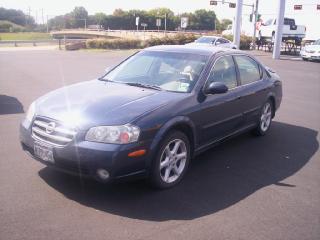We have pretty much decided on getting a Nissan Maxima. Mmmm, 255 horses. We want a model with cloth seats and without a sun roof.
 Yesterday we found a 2002 Maxima with 56K miles (the one pictured to the right). www.autocheck.com showed a clean title history, and a VIN lookup on www.publicdata.com showed that the previous owner lives in Plano and bought the car new. I found this guy’s phone number but am still not able to reach him.
Yesterday we found a 2002 Maxima with 56K miles (the one pictured to the right). www.autocheck.com showed a clean title history, and a VIN lookup on www.publicdata.com showed that the previous owner lives in Plano and bought the car new. I found this guy’s phone number but am still not able to reach him.
Anyway, we took the car home for the night. After getting an uncle to help us examine everything, we discovered that parts of the front and rear bumpers are resprayed, and the rear bumper even has a slight wrinkle in one spot. Since much of the original paint was still there, whatever happened may not have been too severe. However, the repaint was done at a really crappy shop. They sprayed the paint in a moist and dirty environment: there was a place where the paint “fell” a bit, and the paint was full of trash. Because of the apparent crappiness, I have to wonder what else wasn’t fixed right.
An under-engine rock shield is also missing, exposing the underside–especially the A/C compressor and hoses–to kicked up junk. True, this isn’t a big deal; a new shield can be bolted in. But why was it missing in the first place? What caused it to fall off? The same event that damaged the bumpers? What else has fallen off? What else was not properly repaired?
Overall, these are not deal-ending issues, but they reduce what we’re willing to pay for the car. We got the car inspected at our local AAA-certified shop ($90), and it checked out fine. It may be mechanically sound. But I still can’t reach the original owner, so how do I know how it was treated or what it was used for?
Anyway, after a few minutes of back and forth at the dealer their best offer was 4.4% above our maximum price. 4.4% is a nontrivial amount of cash, so we walked. Of course we got the crap about how they won’t make enough money, here is what Kelly Blue Book says, etc.
We walked.
Back to square 1, less $90 and a half day of vacation. It’s a learning experience. I won’t be so quick to drive the next car home unless we have a good idea of what we would pay for it.
 This weekend I attended the first session of
This weekend I attended the first session of  Let’s take the case of a Honda Accord LX V6. Based on friends’ experiences and Consumer Reports reliability ratings going back to 1996, I think it’s reasonable to say that this car will go at least 180,000 miles before requiring costly repairs or becoming unacceptably unreliable.
Let’s take the case of a Honda Accord LX V6. Based on friends’ experiences and Consumer Reports reliability ratings going back to 1996, I think it’s reasonable to say that this car will go at least 180,000 miles before requiring costly repairs or becoming unacceptably unreliable.